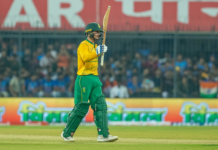Photo Credit: ECB
ECB Chair, Richard Thompson, discusses progress across the game one year after the ICEC’s report into cricket.
As someone who’s loved cricket their whole life, and seen the force for good that our game can be, the publication of the Independent Commission for Equity in Cricket’s (ICEC) report a year ago today was heartbreaking.
At its best, our sport improves people’s lives and brings communities together, something few if any sports can do in the way cricket does. But the ICEC report showed that for too many people, their experience has been very different. There were too many people who had experienced discrimination or felt shut out of our sport, whether because of their gender, ethnicity or class.
I remain dismayed by what the report shared. It exposed very clearly just how much work we have to do if we are to achieve our ambition for cricket to become the most inclusive team sport in England and Wales – and to say we really are a game for all.
I said back then that this was a wake-up call, and an opportunity to reset our sport. In our formal response to the report which we published last September we set out a detailed action plan on behalf of the whole game which we have since been focused on implementing. We know that some change will take considerable time, but we have initially prioritised several key areas where we can make progress and impact swiftly.
To break down barriers to access for children from ethnically diverse backgrounds and at state schools, support them to access talent pathways, and help address the lack of British South Asian representation in professional cricket, we’ve invested an additional £2m in charity partners who have been able to scale up their delivery quickly.
This includes funding delivery of cricket in 350 more state schools this year through Chance to Shine and Lord’s Taverners, targeted at those from lower socio-economic backgrounds and pupils with special educational needs and disabilities. This work will be expanded further to benefit as many as 900,000 more children over the next five years after we successfully secured £35m in additional Government funding.
Our new partnership with the MCC Foundation is already enabling thousands more state school children to access talent pathways with 49 new hubs launched in the past six months and offering additional cricket for state-educated girls and boys. Last year 189 children successfully made it onto their county’s talent pathway programme from a hub. We’re also supporting the ACE Programme to operate in seven cities, providing opportunities for children and young people from Black communities. And by teaming up with the South Asian Cricket Academy (SACA) for the first time, we’ve allowed them to provide more showcase matches to help talented South Asian cricketers make a professional breakthrough so that we can address the gap between the 30% of adult recreational players who are from British South Asian backgrounds compared to the vastly lower representation in the professional game. This has got to change.
To improve the ways that we tackle discrimination across the game we heard clearly that people wanted greater assurance around the separation between the regulatory processes within cricket and the remainder of the ECB. We therefore focused on establishing the Cricket Regulator in December, under which our Anti-Discrimination Unit now sits. As well as enforcing adherence to the game’s regulations, the Regulator is also responsible for providing relevant information and education. It is overseen by an independent Regulatory Board and ring-fenced from the rest of the ECB. Within it, the Anti-Discrimination Unit is leading our work to ensure we better support those who experience discrimination, helping the cricket network to understand discrimination and how to investigate allegations effectively, as well as developing a customer charter to set out the standards for how complaints should be dealt with.
We’re also continuing to support counties to increase diversity within governance across the game. 34% of Directors on county boards are now women – up from 11% in 2019. 19% of Directors on county boards are from ethnically diverse communities – up from 5% in 2019. We also know there is still much work to be done across the game to ensure representation in senior executive roles, such as among Chairs, Chief Executives and Directors of Cricket, and this will be a continuing focus for us all.
There was swift progress we could also make in reducing gaps between pay and standards in the men’s and women’s professional game. Last August we equalised England Women’s match fees with England Men’s match fees, as well as equalising conditions of employment for centrally contracted players, such as tour fees, family provision, insurances. Women’s pay in The Hundred has again been increased for 2024 – with top salaries now £50,000, up from £15,000 when the competition launched – with men’s pay remaining static.
And we’ve increased investment into the women’s domestic cricket from next year – reaching an extra £8m a year by 2027 – as part of the new three-tier structure we are introducing to help turbocharge growth of the women’s and girls’ game. Ultimately the route to pay parity is for the commercial and media rights value of the women’s game to catch up with those of men’s cricket. Our ambition to have 12 professional women’s teams by 2029 would see an 80% increase in the number of professional female players in England and Wales compared to today. And with First Class Counties taking ownership of professional women’s teams, we are ensuring the women’s game will be represented alongside the men’s game in cricket’s decision-making structures.
This isn’t a sum total of the action we are taking, but a flavour of where we have been able to make speedy progress.
It’s clear we still have a long way to go. We will publish a thorough update on our progress against our action plan in September, a year on from its publication. We’ve always been clear that lasting, meaningful change is not a quick fix. It will take time. In some areas we are still building plans to ensure we take the right approach. I’d prefer to take a little longer to do that rather than rush to the wrong solution. I am determined we continue to listen and learn along the way.
In October, we intend to publish a series of action plans recommended by the ICEC to set out our next steps in supporting state school cricket, Black and other ethnically diverse communities, and volunteering.
Critically, the last part of the puzzle will be how everyone ‘feels’ in the game. Wounds take time to heal, trust takes time to rebuild, those who discriminate take time to be found and educated. We aren’t anywhere close to equality yet, we know we have a long way to go.
But we mean it. I hope you can see that in our energy, our unity, our financial investment and our desire to be better.
A year isn’t very long in cricket, but we have done a lot in that time, and I hope people will come with us as we rebuild – and that one day we will be able to look back on the ICEC report as a truly transformative moment for our sport.

















































